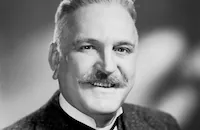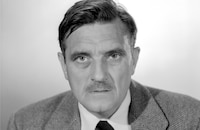The Cockeyed Miracle

Brief Synopsis
Cast & Crew
S. Sylvan Simon
Frank Morgan
Keenan Wynn
Cecil Kellaway
Audrey Totter
Richard Quine
Film Details
Technical Specs

Synopsis
Sam Griggs, a sixty-year-old shipbuilder in failing health, has foolishly and secretly invested his family's savings in a bad real estate venture. In the hopes that he will soon be able to recoup some of his losses, Sam does not reveal the mistake to his wife Amy and his three grown children. He tries desperately to sell the worthless real estate, which he bought in his friend Tom Carter's name, but the only prospective buyer decides to wait until the passing of a storm to see if it holds up to bad weather. While waiting for the deal to go through, Sam dies in his sleep and is transported to the afterlife. There he is reunited with the ghost of his dead father, Ben Griggs. Ben tells his son that the world of the afterlife is a place where money is of no importance and where walls can be walked through with ease. Invisible to his family, Sam watches his wife and children interact, and sees them when they discover his body. When Ben tells Sam that he has special metaphysical powers over the weather, Sam asks him to create a storm over his daughter Jennifer and Howard Bankson, a boarder, to help spur their romance. The trick works, and Sam is pleased to see Howard and Jennifer embrace while taking refuge from the rain. When Sam explains to Ben the danger his family faces if the storm wrecks his property, Ben uses his special powers to control the storm, and, as a result, Tom is able to sell the property for thousands of dollars. While waiting to see his family's reaction to Tom handing over the check, Sam realizes, to his astonishment, that Tom is thinking about keeping the money for himself. Tom is about to leave the Griggses without giving the check to Amy, but Sam and Ben succeed in preventing his departure by creating another storm and sending down a bolt of lightning. Sam vows to haunt Tom until he hands over the check, but his eerie noises cannot be heard in the house. Tom finally decides to pocket the check, and tells Jim that his father lost the family's money in bad stock market investment. As he leaves, though, Tom is unaware that the check has fallen out of his pocket and has landed on the living room floor. While Ben brings the storm to an abrupt end so that Tom will leave, Sam watches in agony as his family walks by the check without noticing it. Moments later, Tom discovers the check missing, and returns to look for it. He finds it and pockets it undetected, but Ben sends down one last lightning stroke that kills him. Assured that his family will now find the check, and that his daughter will be happily married to Howard, Sam joins his father on the journey to the inner world of the afterlife.

Director

S. Sylvan Simon
Cast

Frank Morgan

Keenan Wynn

Cecil Kellaway

Audrey Totter

Richard Quine

Gladys Cooper

Marshall Thompson

Leon Ames
Jane Green

Morris Ankrum
Arthur Space

Naomi Childers

Howard Mitchell
Guy De Wolfe
Robert Anderson
Douglas Madore
Billy Chapin
Susan Simon
Crete Dewolf
Crew
Mark Davis
Jack Dawn
Karen De Wolf
Peter P. Decker
Dale Deverman
Richard Duce
James F. Gaither Jr.
Jack Gertsman
Cedric Gibbons
Mildred Griffiths
Irene
Ray June
Ben Lewis
M. J. Maclaughlin
Earl Mcevoy
Warren Newcombe
Inger Norswing
Ralph A. Pender
George Richelavie
William J. Saracino
Douglas Shearer
Robert W. Shirley
David Snell
Irving Starr
William Steinkamp
Michael Steinore
Valles
Edwin B. Willis

Photo Collections
Film Details
Technical Specs

Articles
The Cockeyed Miracle
Following the trend of stories about benevolent ghosts helping earthbound individuals (Topper (1937), The Canterville Ghost (1944), The Ghost and Mrs. Muir, 1947), The Cockeyed Miracle (1946) traces the death of a 63-year-old shipbuilder in the early 1900s and his reunion in the afterlife with his father, a ne'er-do-well who died at 36. Together, they straighten out the trouble-plagued family the son left behind.
The son is played by 56-year-old Frank Morgan, best known for the title role in The Wizard of Oz (1939). His father is played by 30-year-old Keenan Wynn, an age reversal that, along with the expected ghostly effects and pranks, gives the film much of its humor. Both Morgan and Wynn had their own famous fathers in real life. Morgan was the son of one of the founders of the company that marketed Angostura Bitters used in drinks and cocktails. Wynn's father was the legendary vaudevillian and sometime screen comic Ed Wynn. The younger Wynn had started in films a dozen years earlier and went on to a long and successful career as one of Hollywood's most enduring character actors in just about every genre. His show business pedigree goes even further than his father; his grandfather was silent movie actor Frank Keenan, and his son is screenwriter Tracy Keenan Wynn, whose scripts include those for The Longest Yard (1974) and The Drowning Pool (1975).
The cast features several other familiar names. Richard Quine started out as an actor in the 1940s after a brief youthful career in vaudeville and as a radio singer. He turned to directing a few years after his role in The Cockeyed Miracle with Leather Gloves (1948), although he continued to act in a few more films. Quine had his biggest hits between the mid 50s and mid 60s in his direction of several movies with Jack Lemmon: My Sister Eileen (1955), Operation Mad Ball (1957), Bell, Book and Candle (1958), The Notorious Landlady (1962) and How to Murder Your Wife (1965). He also directed such major stars of the period as William Holden, Doris Day, Judy Holliday, Audrey Hepburn and Kim Novak. But despite his success, his life was marked by tragedy. His first wife, Susan Peters, a promising young actress of the World War II years, was paralyzed in a hunting accident in 1945. She and Quine divorced two years later. Even though she was confined to a wheelchair, Peters attempted a film comeback but finally lost her will to live and starved herself to death at 31. In 1989, Quine, then married to singer-actress Fran Jeffries (The Pink Panther, 1963), shot himself at the age of 69, reportedly because of ill health and career setbacks.
Also in the cast are Audrey Totter, playing her first real ingénue role after several films playing sirens and exotics with different accents and hair colors, and three-year-old Billy Chapin in his screen debut. Nine years later, Billy played the key role of the terrified boy fleeing with his little sister from psychopath Robert Mitchum in The Night of the Hunter (1955). He is the brother of Lauren Chapin, the youngest child on the long-running 1950s sitcom Father Knows Best. Rounding out the cast are notable character actors Cecil Kellaway (The Postman Always Rings Twice, 1946), Leon Ames (Meet Me in St. Louis, 1944) and Gladys Cooper (Now, Voyager, 1942)
Director: S. Sylvan Simon
Producer: Irving Starr
Screenplay: Karen DeWolf, from the play But Not Goodbye by George Seaton
Cinematography: Ray June
Editing: Ben Lewis
Art Direction: Richard Duce, Cedric Gibbons
Original Music: David Snell
Cast: Frank Morgan (Sam Griggs), Keenan Wynn (Ben Griggs), Cecil Kellaway (Tom Carter), Audrey Totter (Jennifer Griggs), Richard Quine (Howard Bankson), Gladys Cooper (Amy Griggs).
BW-83m.
by Rob Nixon

The Cockeyed Miracle
Quotes
All you left Ma and me was a fifteen-dollar saloon bill.- Sam Griggs
I'll thank you to treat you father with more respect.- Ben Griggs
What does she do?- Ben Griggs
She's a librarian.- Sam Griggs
Must read a lot.- Ben Griggs
Look, Pa, no hands!- Sam Griggs
Just as easy as I used to go through a week's pay.- Ben Griggs
Trivia
Notes
The working title of this film was But Not Goodbye. The George Seaton play on which the film is based starred Harry Carey and Wendell Corey.















